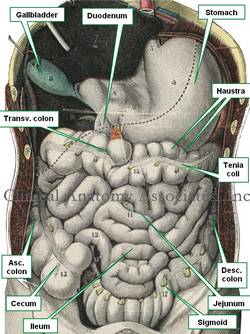The term [tenia coli] is Latin and refers to three longitudinal whitish bands of tissue seen on the surface of the colon. An alternate spelling for this term is [taenia coli].
The word [tenia] is Latin are means "ribbon" or "tape". It is a term used to describe tapeworms. [Coli] is also Latin and means "pertaining to the colon". See accompanying image. Click the image for a larger depiction.
The tenia coli are formed by the gathering or grouping of the longitudinal (external) muscle layer found in the components of the digestive system. While in most of the organs the longitudinal layer is spread out around the organ, in the colon the grouping of the fibers form these three longitudinal bands. The contant tonic contraction of these bands of muscle cause the colonic wall to bunch forming sacculations known as "haustra".
The tenia coli of the cecum converge at the base of the vermiform appendix. This is one anatomical constant used by surgeons to localize and identify the vermiform appendix.
There are three tenia coli best seen in the transverse colon. Because of their relationship with the omentum and the transverse mesocolon, two of them are known as the [tenia omentalis] and the [tenia mesocolica] respectively. The third one is free, and is the easiest one to observe; it is called the "free tenia" or [tenia libera].
The tenia are well formed until the distal portion of the sigmoid colon. When it forms part of the rectosigmoid region all three tenia start to dissipate and spread out until they form the longitudinal layer of the rectum.
Since the small intestine is not necessarily always small in relation to the colon (because of food content, intestinal gases, or pathology), the location of the organ and the presence of haustra, as well as the presence of tenia coli and appendices epiploica, is used to recognize the organ as colon.
Sources:
1. "Dorlands's Illustrated Medical Dictionary" 26th Ed. W.B. Saunders 1994
2. "The origin of Medical Terms" Skinner, AH, 1970
3. "Tratado de Anatomia Humana" Testut et Latarjet 8 Ed. 1931 Salvat Editores, Spain
Image modified from the original from Testut and Latajet, 1931




